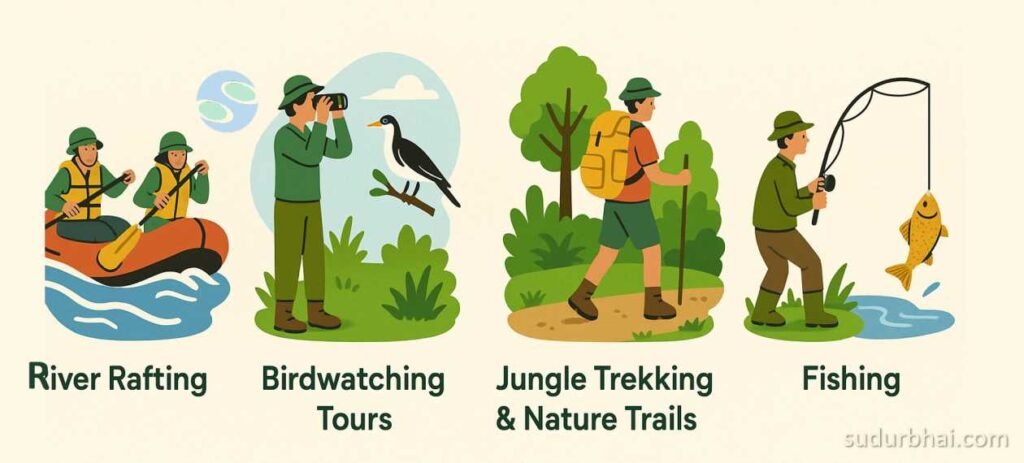Nameri National Park

1. Location and Area of Nameri National Park
- Geographical Location: Located in the northern part of Assam, along the Assam-Arunachal Pradesh border.
District Covered: Sonitpur district, Assam.
Total Area: 200 sq. km
Landscape Features:
Located at the foothills of the Eastern Himalayas.
Shares its northern boundary with Pakke Tiger Reserve (Arunachal Pradesh).
Characterized by tropical evergreen forests, semi-evergreen forests, deciduous forests, and riverine grasslands.

2. Year of Establishment of Nameri National Park
- Declared as a Reserved Forest: 1978.
Declared as a Wildlife Sanctuary: 1985.
Declared as a National Park: 1998.
Declared as a Tiger Reserve: 1999 under Project Tiger.
3. Biodiversity of Nameri National Park
A. Flora of Nameri National Park
Vegetation Types:
Semi-Evergreen and Moist Deciduous Forests.
Tropical Rainforests in some patches.
Riverine Grasslands and Bamboo Groves along the riverbanks.
Dominant Plant Species:
Trees: Hollong (State Tree of Assam), Nahor, Agarwood, Gamari, Amari.
Grasses: Elephant Grass, Barenga Grass, and several aquatic plants.
Riverine Vegetation: Cane, Bamboo, and reeds along the Jia Bhoroli River.
B. Fauna of Nameri National Park
Mammals
Key Species:
Royal Bengal Tiger (Nameri is a part of the larger Kaziranga–Pakke tiger corridor).
Asiatic Elephant (Large population, often migrating from Arunachal Pradesh).
Indian Bison (Gaur).
Leopards and Clouded Leopards.
Sloth Bear.
Wild Boar, Sambar Deer, Barking Deer, and Hog Deer.
Avifauna (Birdlife – Important Bird Area by BirdLife International)
Over 370 species of birds recorded.
Key Bird Species:
White-winged Duck (Endangered, state bird of Assam).
Ruddy Kingfisher, Ibisbill, Wreathed Hornbill, Rufous-necked Hornbill.
Great Pied Hornbill, Blue-bearded Bee-eater, and Black Stork.
Reptiles & Amphibians
King Cobra, Indian Python, Monitor Lizard.
Assam Roofed Turtle and various frog species.
4. Major Rivers and Terrain of Nameri National Park
A. Major Rivers in Nameri National Park
Jia Bhoroli River:
Originates in Arunachal Pradesh and flows through Nameri.
One of the most important riverine ecosystems in Assam.
Supports diverse aquatic species and avifauna.
B. Terrain & Climate in Nameri National Park
Landscape:
A mix of hilly areas, grasslands, dense forests, and riverbanks.
The terrain is undulating with riverine islands and floodplains.
Climate:
Tropical Monsoon Climate with hot summers and cool winters.
Annual Rainfall: 2500-3000 mm, leading to seasonal floods.
5. Conservation Challenges and Successes in Nameri National Park
A. Conservation Challenges in Nameri National Park
Human-Wildlife Conflict
Frequent elephant raids on agricultural fields in villages surrounding the park.
Tiger and leopard attacks on cattle leading to tensions with locals.
Poaching and Illegal Fishing
Illegal hunting of birds and fishing along the Jia Bhoroli River.
Poaching of elephants for ivory and tigers for their body parts.
Deforestation and Encroachment
Timber smuggling and illegal logging in buffer areas.
Expansion of agricultural land leading to loss of habitat.
Impact of Floods and Erosion
Seasonal floods from Jia Bhoroli River damage wildlife habitats.
Soil erosion affects vegetation and animal migration.
B. Conservation Successes in Nameri National Park
Eco-tourism and Community Involvement
Villagers involved in eco-tourism activities like river rafting, birdwatching, and nature guiding.
Local youth employed as forest guards and wildlife monitors.
Tiger Population Recovery
Part of the Kaziranga–Pakke Tiger Corridor, ensuring safe movement of tigers.
Increase in camera-trap sightings of tigers.
Protection of White-Winged Duck and Hornbills
Declared an Important Bird Area (IBA) to conserve endangered avifauna.
Strict monitoring to prevent poaching of rare birds.
Anti-Poaching Measures
Deployment of armed forest guards to tackle poaching.
Night patrolling and drone surveillance introduced.
6. Eco-Tourism and Adventure Activities
River Rafting on Jia Bhoroli River: Organized by the Assam Tourism Department.
Birdwatching Tours: Best for spotting the White-winged Duck, Hornbills, and migratory birds.
Jungle Trekking & Nature Trails: One of the few national parks in Assam that allows walking safaris.
Fishing and Angling: Controlled fishing of Golden Mahseer (Tiger of Indian Rivers).

